Are you ready to unleash your creativity and transform your textiles into works of art? Look no further than the world of fabric dyeing techniques. With a vast array of methods to choose from, you’ll be able to add vibrant color and unique patterns to your fabrics, no matter your skill level.
From the basics of fabric dyeing to the intricacies of shibori, batik, screen printing, and more, this comprehensive guide will take you on a journey through the world of fabric dyeing. Get ready to explore new techniques, experiment with colors and patterns, and discover the joy of creating one-of-a-kind fabrics.
Key Takeaways:
- Unlock a world of vibrant colors and unique patterns with fabric dyeing techniques.
- From the basics of dyeing to advanced techniques like shibori and batik printing, there’s a technique for every level of skill and interest.
- Experiment with natural dyes, gradient effects, and resist techniques to create stunning fabric designs.
- Discover the joy of creating your own fashion pieces, home decor items, and fabric art.
- With the right techniques and care, your dyed fabrics can remain vibrant and beautiful for years to come.
Welcome to the colorful world of fabric dyeing! If you’re new to this art form, you’re in for a treat. Fabric dyeing is the process of adding color to textiles, transforming plain fabrics into vibrant works of art.
There are various types of dyes that can be used, including natural and synthetic, and each fabric type may react differently to different dyes. It’s important to understand the basics of fabric dyeing before diving in, so let’s explore some key concepts together.
- Introduction to types of dyes
- Introduction to fabric types
- Basic concepts of the dyeing process

By understanding these fundamentals, you’ll be on your way to exploring the countless fabric dyeing techniques that await you. Let’s get started!
Basic Dyeing Methods
Before you embark on your fabric dyeing journey, it’s essential to understand the fundamental techniques that form the basis of the art. Basic dyeing methods involve immersing the fabric into a container of dye, applying dye directly onto the fabric, or a combination of both. Here are some of the basic dyeing methods you should know:
- Immersion dyeing: The fabric is completely submerged in a container of dye for a set period, usually between 10 minutes to an hour, depending on the desired color intensity.
- Direct application: The dye is applied directly to the fabric using a brush, sponge, or other applicator. This method is often used for creating detailed designs and patterns.
- Tie-dyeing: Fabric is twisted, folded, and manipulated before dye is applied to create unique and colorful patterns. This method is popular for achieving a psychedelic, 60s-inspired look.
- Gradient dyeing: Create a gradual transition of color on your fabric by dipping it into dye baths with progressively darker concentrations of dye. This method is excellent for creating ombre effects or a smooth gradient between two colors.

Experiment with these basic dyeing methods, and you’ll unleash your creativity with an endless array of colorful and expressive possibilities.
Tie-Dyeing
Get groovy with tie-dyeing techniques and create unique, vibrant patterns on your fabrics. This classic technique involves folding, twisting, and tying fabric before applying the dye, resulting in beautiful and fun patterns. Check out some of these patterns:
- Spiral
- Bullseye
- Stripes
- Crinkle
- Heart
But the fun doesn’t stop there. Modern techniques like ice dyeing, where the ice melts into beautiful designs, are gaining popularity. Try your hand at creating your own design and enjoy the colorful results. Use high-quality dye and experiment with different fabrics to find your perfect combination. This technique is perfect for creating unique fashion pieces or home decor items.

Shibori is a traditional Japanese technique that involves manipulating fabric to create intricate patterns and designs. These techniques typically involve folding, twisting, and binding the fabric before dyeing it. Here are some of the most popular shibori techniques to try:
- Arashi: Achieve a unique striped pattern by wrapping fabric around a pole and scrunching it before dyeing.
- Itajime: Fold and clamp the fabric with wooden blocks to create geometric shapes and patterns.
- Kumo: Pinch and bind fabric to create cloud-like patterns.
- Nui: Stitch the fabric before dyeing to create intricate patterns and shapes.
Shibori techniques can be used alone or in combination to create stunning designs on your fabrics. Experiment with different folding and binding methods to achieve your desired effect. With this technique, the possibilities are endless!
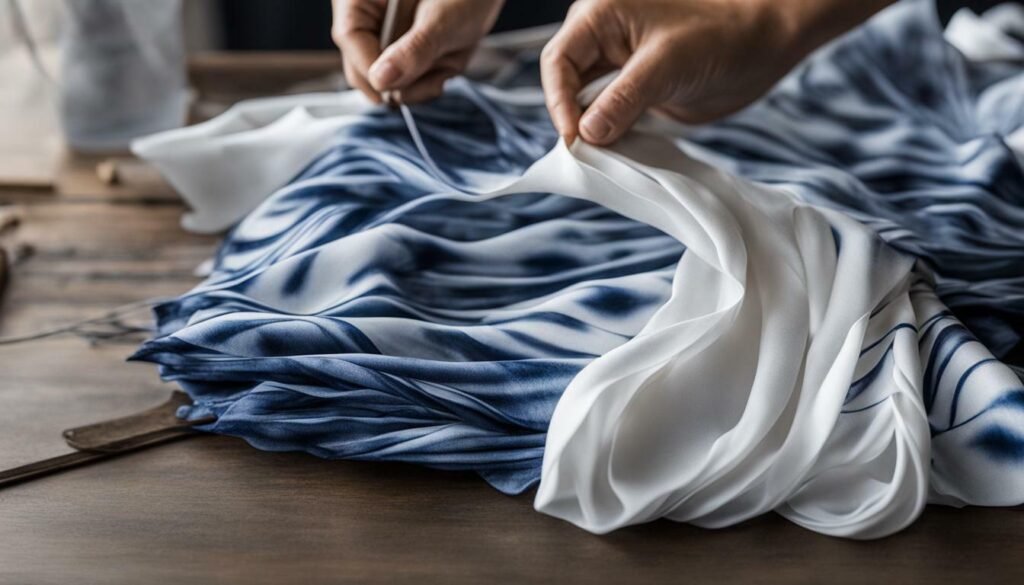
Batik printing is an ancient technique that has been used for centuries to create intricate and beautiful designs on fabric.
To create a batik print, hot wax is applied to the fabric in a pattern or design using a tool called a tjanting. The wax acts as a resist, preventing the dye from penetrating the fabric in the areas where it is applied. The fabric is then dyed, and the wax is removed to reveal the design.
This technique allows for a wide range of designs and patterns, from simple geometric shapes to complex, detailed images. Traditional batik printing often uses natural dyes, but modern techniques also incorporate synthetic dyes.
There are different methods of applying wax, such as block printing or using a stamp, and each method creates a unique effect. Experiment with different wax application techniques to achieve the desired look for your project.
Batik printing is a versatile technique that can be used to create clothing, accessories, and home decor items. Its intricate designs and vibrant colors make it a popular choice for many artists and designers.

If you’re looking to transfer your designs onto fabrics with precision and ease, screen printing is the technique for you. With a screen, ink, and your design, you can create consistent and detailed prints onto a variety of textiles. Here are some tips and tricks to get started with screen printing:
- Choose the right screen: Consider the mesh count of the screen, which affects the amount of ink that will pass through the screen. A higher mesh count means finer details on your print, while a lower mesh count will give a thicker layer of ink.
- Prep your screen: Before applying ink, ensure that your screen is coated with emulsion and your design is properly exposed onto the screen. This will create a stencil that allows ink to pass through onto the fabric.
- Use the right ink: Choose ink that is suitable for the type of fabric you’re printing on, and make sure to mix the ink thoroughly before using it.
- Test your print: Before printing on your final fabric, do a few test prints on scrap fabric to ensure that your design is properly aligned and the ink is applying evenly.
Screen printing allows for endless possibilities, from one-color prints to multi-color designs. Use it to create unique pieces of clothing, tote bags, throw pillows, and more. Get creative with your designs and see how they come to life with screen printing.
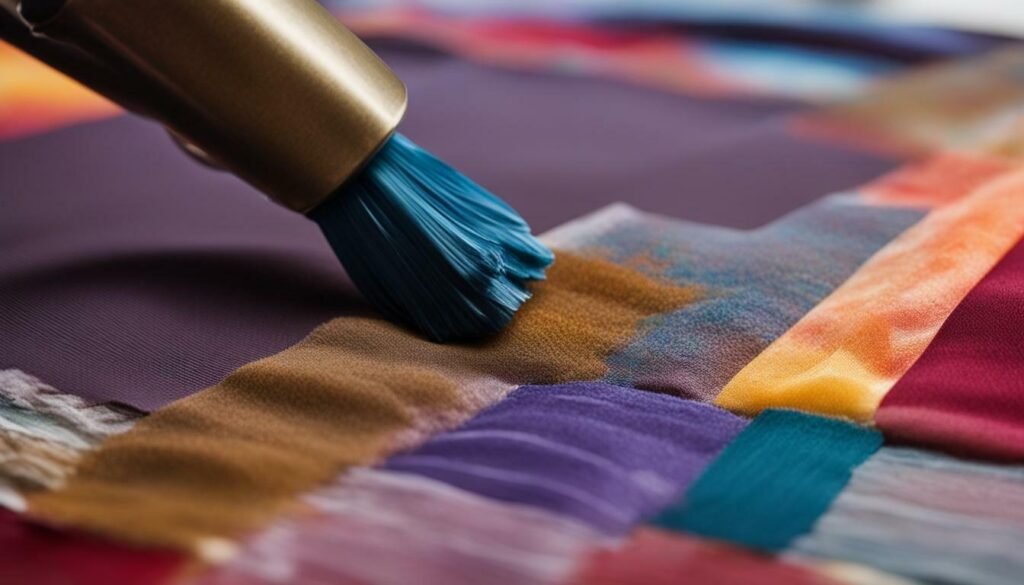
Take a break from synthetic dyes and explore the beauty of natural dyeing. Not only are natural dyes eco-friendly, but they also produce unique and long-lasting colors. Here are the steps to get started:
- Choose your dye materials: You can use plants, fruits, vegetables, and even insects to extract color. Some popular options include avocado pits, onion skins, indigo leaves, and cochineal bugs.
- Prepare your fabric: Natural dyes work best on natural fibers like cotton, linen, silk, and wool. Pre-wash your fabric to remove any finishes that may prevent the dye from absorbing.
- Create your dye bath: Bring your dye material to a boil in a large pot of water. Allow it to simmer for at least an hour to extract as much color as possible.
- Add your fabric: Submerge your fabric in the dye bath and stir it occasionally to ensure even distribution of the dye. The longer you leave the fabric in the dye, the darker the color will be.
- Fix the color: To ensure the dye stays vibrant and doesn’t fade, add a mordant to the dye bath. Common mordants include alum, iron, and tannin.
- Rinse and dry: Once the fabric has absorbed the desired amount of color, rinse it thoroughly in cool water until the water runs clear. Hang the fabric to dry.

Experiment with different dye materials and mordants to create a variety of colors and tones. Play around with different combinations of natural dyes and techniques, such as shibori or gradient dyeing, to achieve unique and beautiful designs.
Gradient Dyeing
Gradient dyeing techniques offer a wide range of possibilities for creating beautiful ombre and gradient effects on your fabrics. This technique involves blending colors together in a seamless manner, transitioning from one shade to another. Here are some tips to help you get started:
- Choose 2-3 colors that blend well together
- Decide on the order of the colors for your gradient
- Prepare your fabric by soaking it in water and wringing it out
- Apply the first dye color to the bottom of the fabric, using your preferred technique
- Gradually add more dye and move up the fabric in sections, blending the colors as you go
- Rinse the fabric in cold water until the water runs clear
- Hang the fabric to dry
Experiment with different methods such as dip-dyeing, pour-over techniques, and more to achieve your desired gradient effect. Remember to start with lighter hues and gradually move to darker ones to achieve a natural-looking gradient. With practice, you’ll be able to create stunning ombre effects on your fabrics that will delight and amaze.
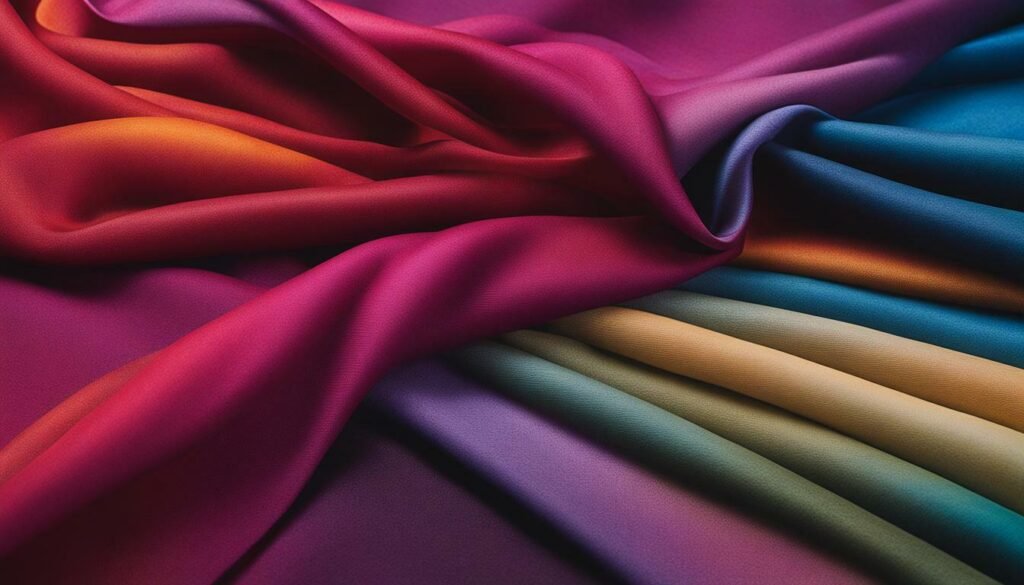
Get ready to get groovy! Tie-dyeing is a fun and accessible technique that allows you to create unique and colorful designs on your fabrics. By folding, twisting, and tying the fabric before dyeing it, you can create a variety of patterns, from classic spirals to modern designs like ice dyeing.
To begin tie-dyeing, you’ll need:
- White or light-colored fabric
- Tie-dye kit or fabric dye
- Rubber bands or string
- Plastic gloves to protect your hands
Once you have your materials, follow these basic steps:
- Wash your fabric and leave it damp.
- Spread the fabric out flat and start folding and twisting it into your desired pattern.
- Use rubber bands or string to secure the folds in place.
- Mix your dye according to the instructions on the package.
- Put on your gloves and apply the dye to the fabric, making sure to saturate all of the folds.
- Wrap the fabric in plastic wrap or a plastic bag and let it sit for several hours or overnight.
- Rinse the fabric under cool water until the water runs clear.
- Remove the rubber bands or string and wash the fabric in cold water with a mild detergent.
- Dry your newly tie-dyed fabric and enjoy!
Remember, the possibilities with tie-dyeing are endless, so don’t be afraid to experiment with different folding techniques and color combinations to create a truly one-of-a-kind fabric. So, grab your materials and get ready to unleash your inner hippie!
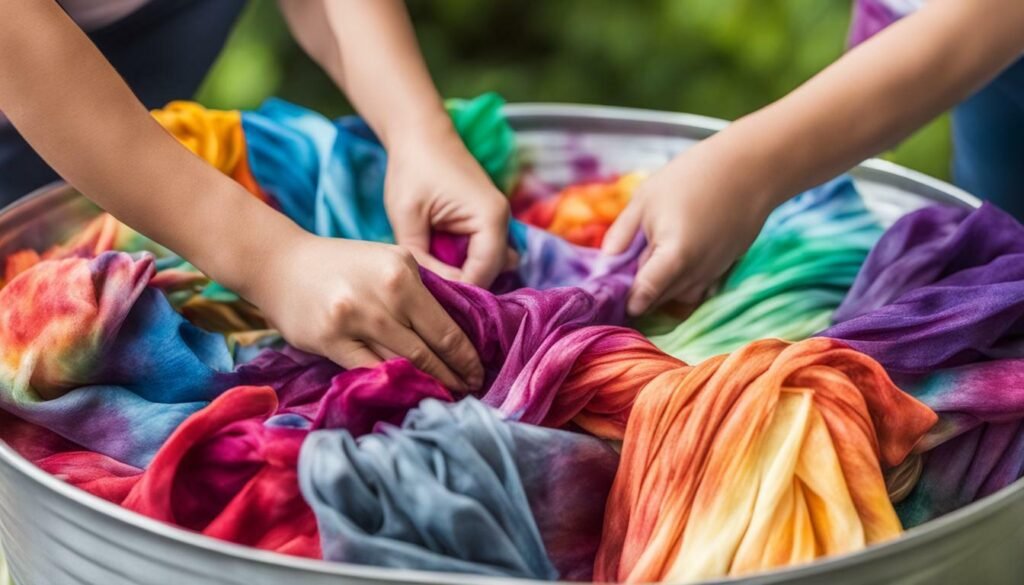
Take your fabric dyeing to the next level with special effects techniques. These techniques add texture, patterns, and dimension to your fabrics and allow you to create unique pieces that stand out from the crowd. Here are some of the special effects techniques you can try:
- Salt dyeing: Sprinkle salt on wet fabric before dyeing to create a mottled effect.
- Ice dyeing: Place ice on top of fabric before applying dye to create a watercolor effect.
- Devoré: Use a chemical process to burn out parts of the fabric and create a sheer, textured pattern.
- Crayon resist: Draw with a white crayon on fabric before dyeing to create a resist and reveal your design.
- Bleach discharge: Use bleach to remove color from fabric and create a unique design.
Experiment with these techniques to create one-of-a-kind fabric pieces that showcase your creativity. Don’t be afraid to mix and match techniques or use them in combination with other dyeing methods to achieve even more stunning results.
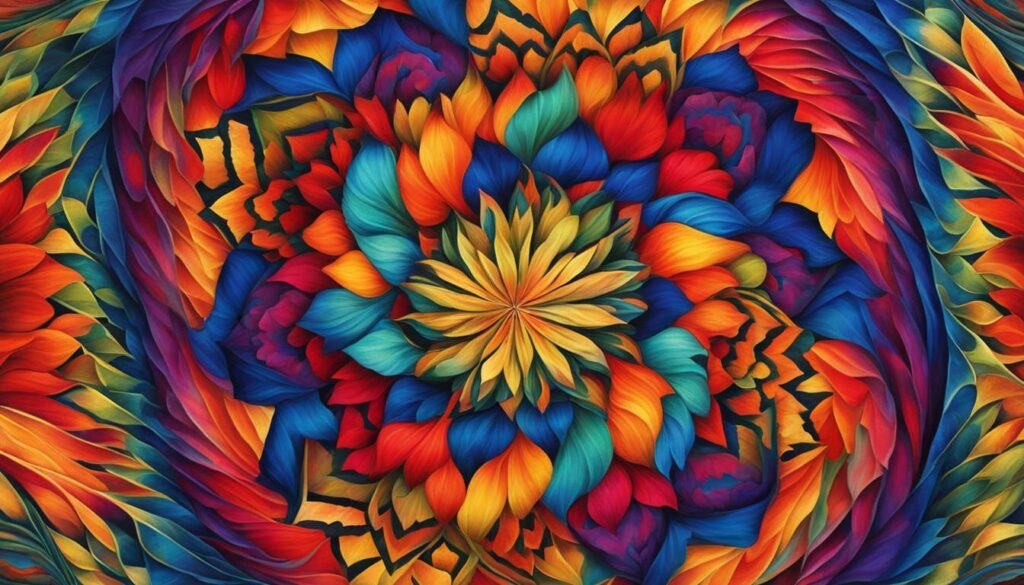
After dyeing your fabrics, it’s important to ensure the colors stay vibrant and long-lasting. Here’s what you need to do:
- Fix the colors by following the instructions on the dye package. This usually involves rinsing the fabric in cold water to remove excess dye, soaking it in a fixative solution, and rinsing it again.
- Wash your dyed fabrics separately or with similar colors in cold water using a gentle, dye-friendly detergent. Avoid using bleach or fabric softeners, which can compromise the color and quality of the fabric.
- Avoid exposing your dyed fabrics to direct sunlight or heat, which can cause fading or discoloration.
- Store your dyed fabrics in a cool, dry place away from direct light and moisture to prevent color transfer or damage.
By following these simple steps, you can ensure that your dyed fabrics stay vibrant and beautiful for years to come.

Now that you’ve learned about various fabric dyeing techniques, it’s time to put your newfound knowledge into practice. Here are some project ideas to get you started and inspire your creativity:
- Create a tie-dyed t-shirt or hoodie using your favorite colors and patterns
- Dye a cotton or linen tablecloth in a beautiful gradient effect for your next dinner party
- Transform an old pair of jeans with shibori techniques, such as arashi or kumo, for a unique and fashionable look
- Make a set of matching napkins and placemats using batik printing techniques for a handmade and custom touch to your dining table
- Decorate your home with a piece of screen-printed fabric artwork that you designed and printed yourself
- Dye a canvas tote bag using natural dyeing techniques for an eco-friendly and stylish accessory
- Create a one-of-a-kind piece of fabric art using special effects techniques, such as salt resist or devoré
Remember, these are just a few ideas to get your creative juices flowing. The possibilities are endless with fabric dyeing, so use your imagination and have fun exploring the techniques to create your own unique projects.
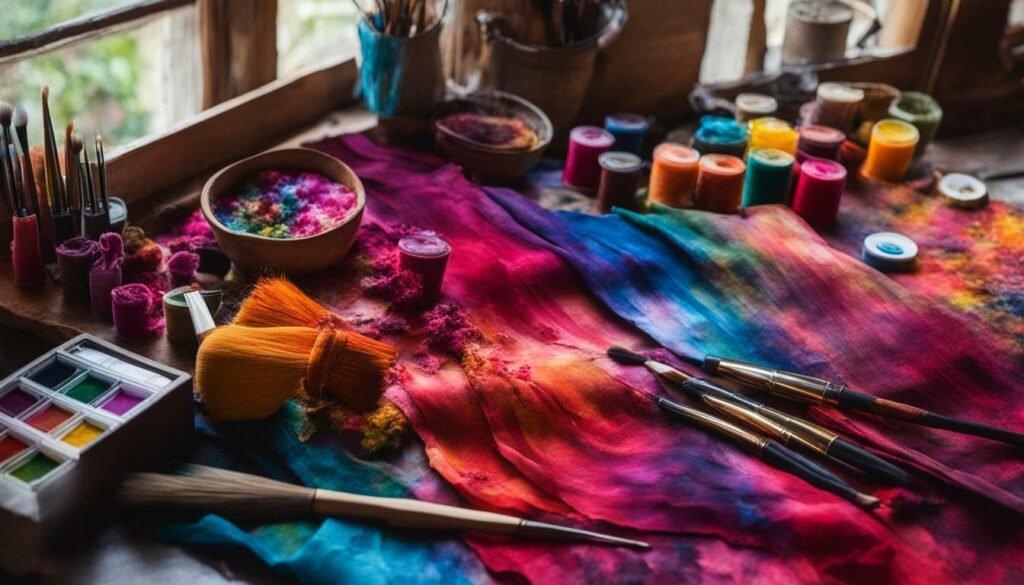
Now that you have explored the world of fabric dyeing techniques, you have the knowledge and inspiration you need to unlock a world of vibrant colors and unleash your creativity on different textiles. By experimenting with these techniques, you can create unique and personalized fabric creations that reflect your style and personality.
To get started, review the different dyeing methods, choose the techniques that inspire you, and begin experimenting with different fabrics, colors, and patterns. Don’t be afraid to make mistakes; the beauty of fabric dyeing is that even unexpected results can lead to beautiful creations.
Remember to follow the basic safety precautions, such as using gloves and working in a well-ventilated area when handling dyes. You should also ensure you properly fix the dyes and take care of your dyed fabrics to keep them looking vibrant and beautiful.
With these fabric dyeing techniques, your creativity has no limits. Whether you’re a beginner or an experienced dyer, the possibilities are endless. So, ignite your creativity, and enjoy the process of transforming your textiles into works of art!
FAQ
What are fabric dyeing techniques?
Fabric dyeing techniques are methods used to apply dye to fabrics in order to create various colors, patterns, and effects. These techniques can be used to transform plain fabrics into vibrant works of art.
Are fabric dyeing techniques suitable for beginners?
Yes! Fabric dyeing techniques can be enjoyed by beginners and experienced dyers alike. There are techniques that are simple and easy to learn, making it accessible for anyone interested in exploring this creative craft.
What types of dyes are commonly used in fabric dyeing?
Common types of dyes used in fabric dyeing include fiber reactive dyes, acid dyes, direct dyes, and natural dyes. Each type of dye has its own characteristics and is suitable for different fabrics.
Can I use fabric dyeing techniques on different types of textiles?
Yes! Fabric dyeing techniques can be used on a wide range of textiles, including cotton, silk, linen, rayon, and more. It’s important to consider the fiber content and care instructions of the fabric before selecting the dyeing technique.
What is tie-dyeing?
Tie-dyeing is a fabric dyeing technique where fabric is folded, twisted, or tied in various ways before applying dye. This creates unique and vibrant patterns on the fabric, making each piece one-of-a-kind.
What is shibori?
Shibori is a Japanese fabric dyeing technique that involves folding, pleating, or binding fabric before dyeing to create intricate patterns. It is known for its beautiful and mesmerizing designs.
What is batik printing?
Batik printing is an ancient wax-resist dyeing technique that originated in Indonesia. Hot wax is applied to fabric in specific areas to create a resist, and then the fabric is dyed to reveal patterns and designs.
How does screen printing work?
Screen printing is a technique where a design is transferred onto fabric using a screen and ink. The design is created on a fine mesh screen, and the ink is forced through the screen onto the fabric to create the desired pattern or image.
What are natural dyes?
Natural dyes are dyes made from plant materials, such as leaves, roots, and berries. They can also be derived from other natural sources like insects and minerals. Natural dyeing is an eco-friendly way to add color to fabric.
How can I create gradient effects on fabric?
Gradient dyeing techniques allow you to create ombre and seamless color transitions on fabric. This can be achieved through methods like dip-dyeing, pour-over techniques, or using specialized tools to blend colors together.
What are resist dyeing techniques?
Resist dyeing techniques involve creating areas on fabric that resist dye penetration. This can be achieved through methods like wax resist, paste resist, or tying fabric before dyeing. These techniques create patterns and designs on the fabric.
Are there any special effects techniques in fabric dyeing?
Yes! Special effects techniques in fabric dyeing allow you to create textures, patterns, and dimensional effects. Some examples include salt dyeing, ice dyeing, devoré (burnout), and more.
How can I make the dye on fabric permanent?
Fixing dyes on fabric is an important step to ensure the colors remain vibrant and long-lasting. This can be done through heat-setting or using fixatives specific to the type of dye used.
How do I care for dyed fabrics?
Caring for dyed fabrics involves following the care instructions provided for the specific type of dye and fabric used. In general, it’s important to wash dyed fabrics with similar colors, avoid harsh detergents, and dry them away from direct sunlight to maintain their beauty over time.
Can you provide some project ideas and inspiration for fabric dyeing?
Certainly! Our article includes a collection of fabric dyeing projects that range from simple to advanced. Whether you’re interested in revamping old clothes, creating unique home decor items, or experimenting with fabric art, you’ll find plenty of ideas and inspiration to fuel your creativity.
